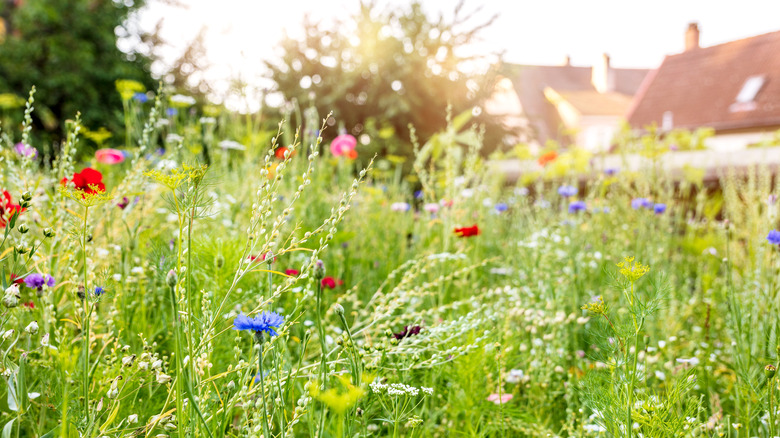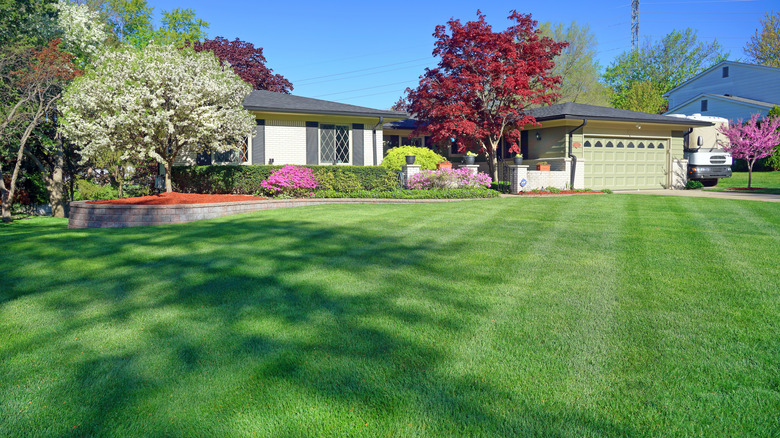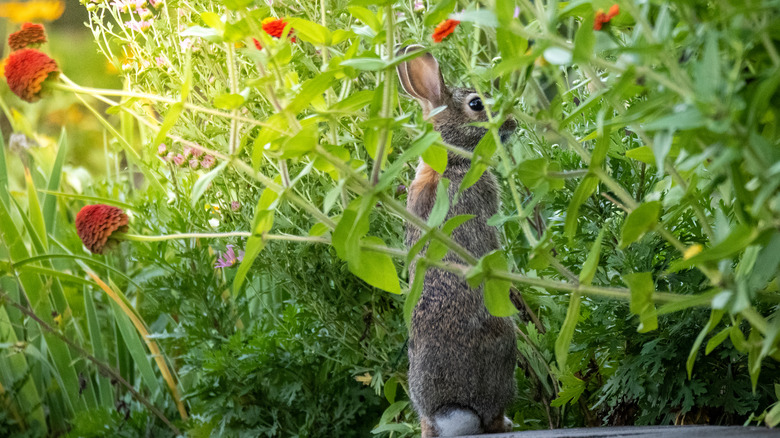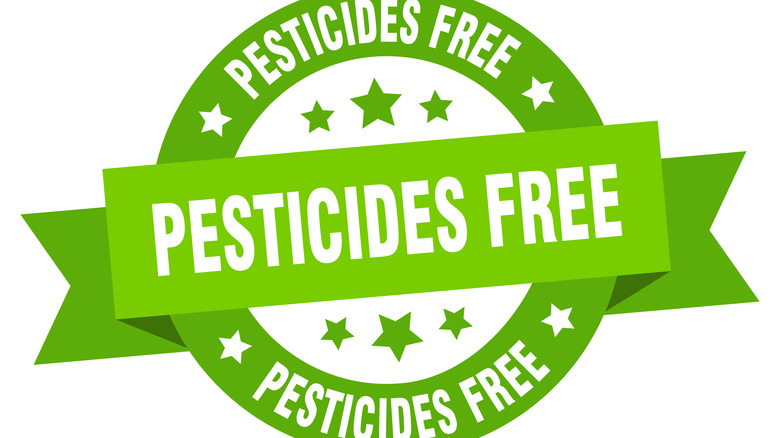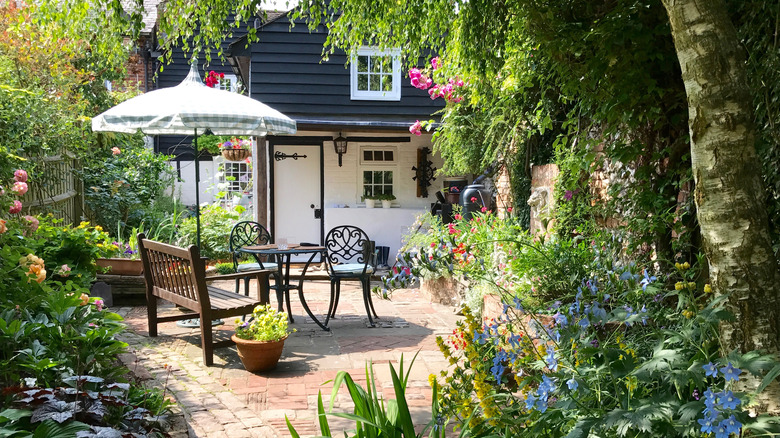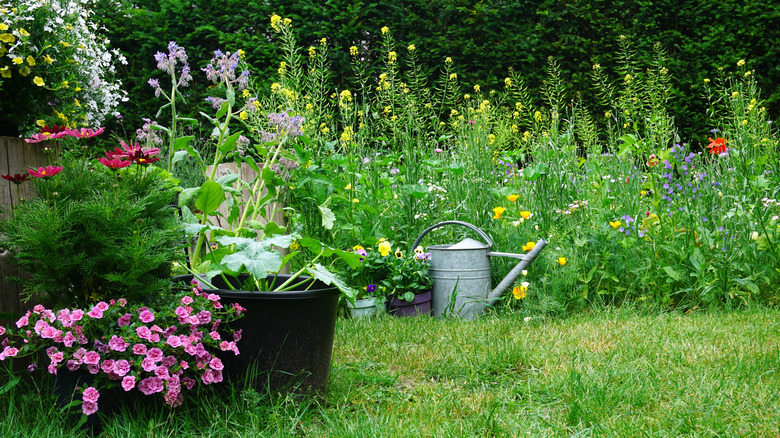What We Know About The Latest Ungardening Trend
Have you ever wondered what your yard would look like if it had never been cleared? What would exist in place of your freshly mowed lawn, perfectly maintained garden beds, and weed-free walkways? RTL Luxembourg reports that ungardening — the process of ushering a manicured landscape back to its naturalistic identity — is now a growing trend in suburban landscaping. It's a proven way to create a sustainable ecology that will soon have your yard feeling less like a golf course and more like a certified wildlife habitat.
Before you dive in with both feet, understand that you can't simply stop mowing your lawn and think your yard will turn itself back into a forest. Treehugger notes that the term ungardening does not signal an end to gardening. Instead, it's a style of horticulture and landscape design that leans not on the tidying up and the mowing and trimming, but on the unruly and the wild; it allows nature to have a say in where and how it will go. Ultimately, through ungardening, we open up our arms and re-welcome the natural world back home.
Say goodbye to the manicured lawn
The crisp clean lines of a manicured lawn will become a thing of your past as you venture down the road of rewilding your landscape. As reported by HuffPost, because there are so many bright green lawns across the U.S., grass has become the most irrigated crop in the country. Together with the chemicals and excessive amounts of water it takes to maintain them — 900 liters per person every day — lawns comprise a significantly negative environmental impact.
In the place of grass should go native woodland flowers such as trilliums, gingers, and foamflowers, suggest plant designers Thomas Rainer and Claudia West in an interview with the Washington Post. Their approach to naturalism revolves around understanding the shapes and behaviors of plants as well as their intricate root systems. In the same article, landscape architect W. Gary Smith said of the pair and their work, "What these guys are doing is showing how to plant landscapes from the soil up. It's not just about plant combinations, textures, colors; it's about looking at plant communities in the wild as an inspiration for design. It's a hybrid of horticulture and ecology, and it's been a long time coming."
Less is truly more in the case of a naturalistic landscape. When compared to a manicured lawn, it will cost considerably less money in the long run and take less time and work to maintain.
Welcome back the wildlife
Seems like it would be rude to encourage a rewilding of your plants without extending the invitation to the wildlife, doesn't it? Formal invitations won't be necessary because it's all just part of the package. As you ungarden your landscape with a return to nature's bounty of native flora, the fauna — bunnies, foxes, squirrels, groundhogs, and more — will arrive just in time for the party too. There's plenty you can do to get out the message; for example, creating a water feature like a small pond is one way to let nature in.
In an interview with The Guardian, wildlife gardening expert Jenny Steel said, "Birds need to drink and keep their feathers clean, so if you have room for a small wetland area, like a little pond, that's a fantastic habitat. It's somewhere not only birds and mammals will come to drink, but you'll also get dragonflies, and frogs will spawn there." Treehugger notes that a manmade pond can be constructed in your backyard for a few hundred dollars over the course of a day. With a shovel, a pair of scissors, and a hose as your complete list of necessary tools, you can create a natural wildlife habitat that will require neither electricity, pumps, nor filters. Lay out a few apples and salt licks, plant a patch of herbs, and before you know it, you'll have deer perusing your backyard for a daily snack, notes Backyard Boss.
Step away from the pesticides
It makes sense that a nature-inspired landscape needs to stay, well, natural. In this case, natural refers to more than native plants and wildlife, it also means a native ecosystem supporting itself from all angles. Jenny Steel told The Guardian, "If you're using pesticides and sprays, you're basically removing a big food source, especially for birds, as they feed on small invertebrates. Say you've got lots of aphids eating your roses: you can encourage blue tits to come and eat those aphids by hanging a bird feeder next to the roses."
Rather than spraying toxic chemicals, the idea is to get the wildlife in on the job of managing pests. There are plenty of easy ways to bring beneficial insects into your yard, and by doing so, you build on the yard's ability to sustain and maintain itself without the need for pesticides. You may even want to attract owls to your yard. According to Bird Informer, these birds of prey are effective carnivorous hunters. One of the best ways to entice them is to serve up their favorite cuisine. That doesn't mean birdseed or nectar-filled flowers; for owls, it means creating a natural environment for rodents like mice, voles, and frogs. And come to think of it, frogs feed on insects too. Are you seeing the pattern here? Allow the pests and prey to return while trusting that their natural predators will take care of any ensuing problems.
Consider the design
Just because you've decided to ungarden your yard doesn't mean you'll end up with an overgrown mess. Per the Washington Post, Thomas Rainer says the key is to "design [your landscape] in a way that it doesn't look wild." You can still have a patio and some order to everything, but the focus will be on what would exist in the space naturally. Rainer adds, "The best design interprets nature; it doesn't imitate it."
The National Wildlife Federation (NWF) suggests many different ways to design a wild garden, noting the importance of understanding the natural state of your existing soil and opting for plants that will thrive in it without the benefit of amendments and other soil conditioners. It may seem strange at first to renounce the almighty compost but, as NWF points out, your yard cannot support a diverse array of wildlife if it's amended to host the same box-store-bought plants that happen to be trendy this season. Instead of keeping up with the neighbors, pay closer attention to the specifics of your own micro-environment. What is the soil like on its own? What are the natural light conditions? Gathering information will allow you to work with a gardening specialist to choose the plants that will thrive in the exact conditions your yard offers.
How to start ungardening your yard
While, at its heart, ungardening is a nod to the free-spirited nature freaks, the process of untangling your yard from the decades of manicuring that it has endured will take more than just letting it go free. This may sound contrary to the spirit of ungardening, but making a plan is always a good idea. Jenny Steel explained to The Guardian, "The idea of leaving a garden so it goes wild is a myth. A garden needs to be managed, because if you don't manage it, all you end up with is nettles — and you need a diversity of plants to attract different types of wildlife."
Take the first step by reading up on the native plants of your area with a heavy focus on those that attract pollinators. Hummingbirds, bees, butterflies, and moths will do wonders to increase the aliveness of your yard. Also, seek guidance from a local expert, such as Aubree Keurajian, an ecologist who runs workshops in plant identification and offers yard consultations via her company, Ungardening. She points out that environmental restoration projects don't need to be massive-scale missions led by a local government or land trust, they can start right in your backyard in a single raised bed or planter.
